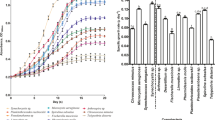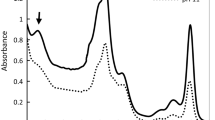Abstract
Cyanobacteria are highly adaptable microorganisms, characterized by an ability to survive in different environments with unfavorable conditions. In order to determine the content and composition of phycobiliproteins in cyanobacterial strains, depending on environmental factors, such as drought, darkness, and lack of nutrients in the substrate, the quantity of these pigments was investigated in 21 cyanobacterial strains. The study was conducted with terrestrial, filamentous, N2-fixing cyanobacterial strains, which belong to Nostoc and Anabaena genera, isolated from different soil types in the Vojvodina region (Serbia). All strains were cultivated in nitrogen-free medium, medium with nitrate concentration of 2 g L−1 in the presence of light, and in drought conditions (water activity less than 0.5 %), on inorganic substrate, in the dark. Statistically significant differences of phycocyanin and allophycocyanin contents were found in the case of strains cultivated in nitrogen-free medium compared to strains grown in the medium containing nitrogen. There were no statistically significant differences in phycoerythrin and total phycobilin contents between strains grown in media with and without nitrogen. The results suggest that nitrogen availability affects composition of phycobiliproteins in the tested strains without affecting the total phycobiliprotein content, which implies maintenance of balanced pigment abundance as cyanobacterial response to nitrogen source. Significantly lower concentrations of the studied pigments, which varied from 0.8 to 16.9 μg mg−1 dry weight, were detected in strains exposed to dry and dark conditions. These data indicate the presence of preserved phycobiliproteins after a period of 10 years of cyanobacterial exposure to drought and darkness, which can be of great importance for the study on their stability under unfavorable environmental conditions.






Similar content being viewed by others
References
Allen MM, Smith AJ (1969) Nitrogen chlorosis in blue-green algae. Arch Microbiol 69:114–120
Bennett A, Bogorad L (1973) Complementary chromatic adaptation in a filamentous blue-green alga. J Cell Biol 58:419–435
Borowitzka MA (1995) Microalgae as sources of pharmaceuticals and other biologically active compounds. J Appl Phycol 7:3–15
Bratlie MS, Johansen J, Sherman BT, Huang DW, Lempicki RA, Drablos F (2010) Gene duplications in prokaryotes can be associated with environmental adaptation. BMC Genomics 11:588. doi:10.1186/1471-2164-11-588
Carr NG (1988) Nitrogen reserves and dynamic reservoirs in cyanobacteria. In: Rogers LJ, Gallon JR (eds) Biochemistry of the algae and cyanobacteria. Clarendon, Oxford, pp 13–21
Chaneva G, Furnadzhieva S, Minkova K, Lukavsky J (2007) Effect of light and temperature on the cyanobacterium Arthronema africanum—a prospective phycobiliprotein-producing strain. J Appl Phycol 19:537–544
Cohen-Bazire G, Bryant DA (1982) Phycobilisomes: composition and structure. In: Carr NG, Whitton BA (eds) The Biology of Cyanobacteria. Blackwell Scientific Publications, Oxford, pp 143–190
Collier JL, Grossman AR (1992) Chlorosis induced by nutrient deprivation in Synechococcus sp. strain PCC 7942: not all bleaching is the same. J Bacteriol 174:4718–4726
Eriksen NT (2008) Production of phycocyanin—a pigment with applications in biology, biotechnology, foods and medicine. Appl Microbiol Biotechnol 80:1–14
Fay P (1992) Oxigen relations of nitrogen fixation in cyanobacteria. Microbiol Rev 56:340–373
Foulds IJ, Carr NG (1977) A proteolytic enzyme degrading phycocyanin in the cyanobacterium Anabaena cylindrica. FEMS Microbiol Lett 2:117–119
Fraser C, Alm EJ, Polz MF, Spratt BG, Hanage WP (2009) The bacterial species challenge: making sense of genetic and ecological diversity. Science 323:741–746
Giardi MT, Masojidek J, Godde D (1997) Effects of abiotic stresses on the turnover of the D1 reaction center II protein. Physiol Plant 101:635–642
Glazer AN (1988) Phycobilisomes. Methods Enzymol 167:304–312
Glazer AN (1994) Phycobiliproteins—a family of valuable, widely used fluorophores. J Appl Phycol 6:105–112
Green JL, Bohannan BJ, Whitaker RJ (2008) Microbial biogeography: from taxonomy to traits. Science 320:1039–1043
Grossman AR, Schaefer MR, Chiang GG, Collier JL (1993) The phycobilisome, a light-harvesting complex responsive to environmental conditions. Microbiol Rev 57:725–749
Grossman AR, Schaefer MR, Chiang GG, Collier JL (1994) The responses of cyanobacteria to environmental conditions: light and nutrients. In: Bryant DA (ed) The molecular biology of cyanobacteria. Kluwer Academic, Dordrecht, pp 641–675
Grossman AR, Bhaya D, He Q (2001) Tracking the light environment by cyanobacteria and the dynamic nature of light harvesting. J Biol Chem 276:11449–11452
Guerrero MG, Lara C (1987) Assimilation of inorganic nitrogen. In: Fay P, Van Baalen C (eds) The cyanobacteria. Elsevier, Amsterdam, pp 163–186
Guimarães M, Plastino EM, Destombe C (2003) Green mutant frequency in natural population of Gracilaria domingensis (Gracilariales, Rhodophyta) from Brazil. Eur J Phycol 38:165–169
Gupta A, Sainis JK (2010) Isolation of C-phycocyanin from Synechococcus sp. (Anacystis nidulans BD1). J Appl Phycol 22:231–233
Hemlata, Fatma T (2009) Screening of cyanobacteria for phycobiliproteins and effect of different environmental stress on its yield. Bull Environ Contam Toxicol 83:509–515
Jensen TE (1993) Cyanobacterial ultrastructure. In: Berner T (ed) Ultrastructure of microalgae. CRC, Boca Raton, pp 7–51
Karnieli A (1997) Development and implementation of spectral crust index over dune sands. J Remote Sensing 18:1207–1220
Kaushik BD (2000) Screening of cyanobacterial strains for natural colours. Indian Hydrobiol 3:81–84
Küpper H, Andresen E, Wiegert S, Simek M, Leitenmaier B, Setlík I (2009) Reversible coupling of individual phycobiliprotein isoforms during state transitions in the cyanobacterium Trichodesmium analysed by single-cell fluorescence kinetic measurements. Biochim Biophys Acta 1787:155–167
Lan S, Wu L, Zhang D, Hu C, Liu Y (2010) Effects of drought and salt stresses on man-made cyanobacterial crusts. Europ J Soil Biol 46:381–386
Levasseur M, Thomson PA, Harrison PJ (1993) Physiological acclimation of marine phytoplankton to different nitrogen sources. J Phycol 29:587–595
Liotenberg S, Campbell D, Rippka R, Houmard J, Tandeau de Marsac N (1996) Effect of the nitrogen source on phycobiliprotein synthesis and cell reserves in a chromatically adapting filamentous cyanobacterium. Microbiology 142:611–622
Loreto C, Rosales N, Bermudez J, Morales E (2003) Pigment and protein production of the cyanobacterium Anabaena PCC 7120 in relation to nitrogen concentration and irradiance. Gayana Bot 60:83–89
Lüder UH, Wiencke C, Knoetzel J (2002) Acclimation of photosynthesis and pigments during and after six months of darkness in Palmaria decipiens (Rhodophyta): a study to simulate Antarctic winter sea ice cover. J Phycol 38:904–913
MacColl R (1998) Cyanobacterial phycobilisomes. J Struct Biol 124:311–334
Manoharan K, Lee TK, Cha JM, Kim JH, Lee WS, Chang M, Park CW, Cho JH (1999) Acclimation of Prorocentrum minimum (Dinophyceae) to prolonged darkness by use of an alternative carbon source from triacylglycerides and galactolipids. J Phycol 35:287–292
McKnight DM, Howes BL, Taylor CD, Goehringer DD (2000) Phytoplankton dynamics in a stably stratified Antarctic lake during winter darkness. J Phycol 36:852–861
Montechiaro F, Giordano M (2006) Effect of prolonged dark incubation on pigments and photosynthesis of the cave-dwelling cyanobacterium Phormidium autumnale (Oscillatoriales, Cyanobacteria). Phycologia 6:704–710
Montechiaro F, Hirschmugl CJ, Raven JA, Giordano M (2006) Homeostasis of cell composition during prolonged darkness. Plant, Cell and Environment 29:2198–2204
Moreno J, Rodriguez H, Vargas MA, Rivas J, Guerrero MG (1995) Nitrogen-fixing cyanobacteria as source of phycobiliprotein pigments. Composition and growth performance of ten filamentous heterocystous strains. J Appl Phycol 7:17–23
Patel A, Mishra S, Pawar R, Ghosh PK (2005) Purification and characterization of C-phycocyanin from cyanobacterial species of marine and freshwater habitat. Protein Expr Purif 40:248–255
Peter P, Sarma AP, Azeem ul Hasan MD, Murthy SDS (2010) Studies on the impact of nitrogen starvation on the photosynthetic pigments through spectral properties of the cyanobacterium Spirulina platensis: identification of target phycobiliprotein under nitrogen chlorosis. Bot Res Int 3:30–34
Plastino EM, Guimarães M, Maholt SR, Oliviera EC (1999) Codominant inheritance of polymorphic colour variants of Gracilaria domingensis (Gracilariales, Rhodophyta). Genet Mol Biol 22:105–108
Plastino EM, Ursi S, Fujii MT (2003) Color inheritance, pigment characterization, and growth of a rare light green strain of Gracilaria birdiae (Gracilariales, Rhodophyta). Phycol Res 52:45–52
Potts M (1994) Desiccation tolerance of prokaryotes. Microbiol Rev 58:755–805
Potts M (1999) Mechanisms of desiccation tolerance in cyanobacteria. Eur J Phycol 34:319–328
Prasanna R, Kaushik BD (2005) Algal diversity—from morphology to molecules In: Satyanarayana T, Johri BN (eds) Microbial diversity: current perspectives and potential applications. IK International, New Delhi, pp 323–344
Prasanna R, Pabby A, Saxena S, Singh PK (2004) Modulation of pigment profiles of Calothrix elenkenii in response to environmental stresses. J Plant Physiol 161:1125–1132
Qiu B, Gao K (2001) Photosynthetic characteristics of the terrestrial blue-green alga Nostoc flagelliforme. Eur J Phycol 36:147–156
Rippka R, Deruelles J, Waterbury JB, Herdman M, Stanier RY (1979) Generic assignments, strain histories and properties of pure cultures of cyanobacteria. J Gen Microbiol 111:1–61
Sauer J, Görl M, Forchhammer K (1999) Nitrogen starvation in Synechococcus PCC 7942: involvement of glutamine synthetase and NtcA in phycobiliprotein degradation and survival. Arch Microbiol 172:247–255
Sauer J, Schreiber U, Schmid R, Völker U, Forchhammer K (2001) Nitrogen starvation-induced chlorosis in Synechococcus PCC 7942. Low-Level Photosynthesis as a mechanism of long-term survival. Plant Physiol 126:233–243
Schirrmeister BE, Antonelli A, Bagheri CH (2011) The origin of multicellularity in cyanobacteria. BMC Evolutionary Biology 11:45. doi:10.1186/1471-2148-11-45
Schwartz R, Grossman RA (1998) A response regulator of cyanobacteria integrates diverse environmental signals and is critical for survival under extreme conditions. Proc Natl Acad Sci USA Plant Biology 95:11008–11013
Stewart WDP, Rowell P, Cossar JD, Kerby NW (1985) Physiological studies on N2-fixing cyanobacteria. In: Ludden PW, Burris JE (eds) Nitrogen fixation and CO2 metabolism. Elsevier, Amsterdam, pp 269–279
Summons RE, Jahnke LL, Hope JM, Logan GA (1999) 2-Methylhopanoids as biomarkers for cyanobacterial oxygenic photosynthesis. Nature 400:554–557
Suter GW, Holzwarth AR (1987) A kinetic model for the energy transfer in phycobilisomes. Biophys J 52:673–683
Tandeau de Marsac N (1977) Occurrence and nature of chromatic adaptation in cyanobacteria. J Bacteriol 130:82–91
Tandeau de Marsac N (1983) Phycobilisomes and complementary chromatic adaptation in cyanobacteria. Bull Inst Pasteur 81:201–254
Tandeau de Marsac N, Houmard J (1993) Adaptation of cyanobacteria to environmental stimuli: new steps towards molecular mechanisms. FEMS Microbiol Rev 104:119–190
Tandeau de Marsac N, Lee HM, Hisbergues M, Castets AM, Bédu S (2001) Control of nitrogen and carbon metabolism in cyanobacteria. J Appl Phycol 13:287–292
Tang DS, Shi SY, Li DH, Hu CX, Liu YD (2007) Physiological and biochemical responses of Scytonema javanicum (cyanobacterium) to salt stress. J Arid Environ 71:312–320
Ting CS, Rocap G, King J, Chishol SW (2002) Cyanobacterial photosynthesis in the oceans: the origins and significance of divergent light-harvesting strategies. Trends Microbiol 10:134–142
Whitton BA, Potts M (2000) Introduction to the cyanobacteria. In: Whitton BA, Potts M (eds) The ecology of cyanobacteria: their diversity in time and space. Kluwer Academic, Dordrecht, pp 1–11
Ye C, Gao K, Giordano M (2008) The odd behaviour of carbonic anhydrase in the terrestrial cyanobacterium Nostoc flagelliforme during hydration–dehydration cycles. Environ Microbiol 10:1018–1023
Yokoya NS, Necchi O, Martins AP, Gonzalez SF, Plastino E (2007) Growth responses and photosynthetic characteristics of wild and phycoerythrin-deficient strains of Hypnea musciformis (Rhodophyta). J Appl Phycol 19:197–205
Acknowledgments
This study has been supported by the funding of the Ministry of Education and Science of the Serbian Government (project number, iii 43002), which is greatly acknowledged.
Author information
Authors and Affiliations
Corresponding author
Rights and permissions
About this article
Cite this article
Simeunović, J., Bešlin, K., Svirčev, Z. et al. Impact of nitrogen and drought on phycobiliprotein content in terrestrial cyanobacterial strains. J Appl Phycol 25, 597–607 (2013). https://doi.org/10.1007/s10811-012-9894-1
Received:
Revised:
Accepted:
Published:
Issue Date:
DOI: https://doi.org/10.1007/s10811-012-9894-1




